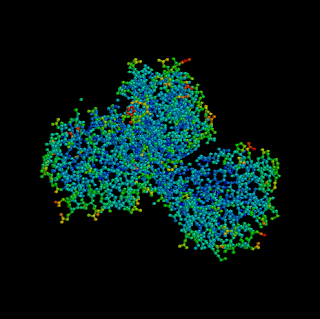The PDB archive contains information about experimentally-determined structures of proteins, nucleic acids, and complex assemblies. As a member of the wwPDB, the RCSB PDB curates and annotates PDB data according to agreed upon standards.
The RCSB PDB also provides a variety of tools and resources. Users can perform simple and advanced searches based on annotations relating to sequence, structure and function. These molecules are visualized, downloaded, and analyzed by users who range from students to specialized scientists.
The Protein Data Bank (PDB) is a repository for the 3-D structural data of large biological molecules, such as proteins and nucleic acids. (See also crystallographic database). The data, typically obtained by X-ray crystallography or NMR spectroscopy and submitted by biologists and biochemists from around the world, are freely accessible on the Internet via the websites of its member organisations (PDBe, PDBj, and RCSB). The PDB is overseen by an organization called the Worldwide Protein Data Bank, wwPDB.
The PDB is a key resource in areas of structural biology, such as structural genomics. Most major scientific journals, and some funding agencies, such as the NIH in the USA, now require scientists to submit their structure data to the PDB. If the contents of the PDB are thought of as primary data, then there are hundreds of derived (i.e., secondary) databases that categorize the data differently. For example, both SCOP and CATH categorize structures according to type of structure and assumed evolutionary relations; GO categorize structures based on genes.
STRUCTURE
 | ||
| HtrA |
 |
| LonA |
 |
| ClpP |
SUMMARY
For HtrA, (Rv3671c) a putative serine protease, is crucial for persistence of Mycobacterium tuberculosis in the hostile environment of the phagosome. We show that Rv3671c is required for M. tuberculosis resistance to oxidative stress in addition to its role in protection from acidification. Structural and biochemical analyses demonstrate that the periplasmic domain of Rv3671c is a functional serine protease of the chymotrypsin family and, remarkably, that its activity increases on oxidation. High-resolution crystal structures of this protease in an active strained state and in an inactive relaxed state reveal that a solvent-exposed disulfide bond controls the protease activity by constraining two distant regions of Rv3671c and stabilizing it in the catalytically active conformation. In vitro biochemical studies confirm that activation of the protease in an oxidative environment is dependent on this reversible disulfide bond. These results suggest that the disulfide bond modulates activity of Rv3671c depending on the oxidative environment in vivo.
For Lon ATP-dependent proteases are key components of the protein quality control systems of bacterial cells and eukaryotic organelles. Eubacterial Lon proteases contain an N-terminal domain, an ATPase domain, and a protease domain, all in one polypeptide chain. The N-terminal domain is thought to be involved in substrate recognition, the ATPase domain in substrate unfolding and translocation into the protease chamber, and the protease domain in the hydrolysis of polypeptides into small peptide fragments. Like other AAA+ ATPases and self-compartmentalising proteases, Lon functions as an oligomeric complex, although the subunit stoichiometry is currently unclear. Here, we present crystal structures of truncated versions of Lon protease from Bacillus subtilis (BsLon), which reveal previously unknown architectural features of Lon complexes. Our analytical ultracentrifugation and electron microscopy show different oligomerisation of Lon proteases from two different bacterial species, Aquifex aeolicus and B. subtilis. The structure of BsLon-AP shows a hexameric complex consisting of a small part of the N-terminal domain, the ATPase, and protease domains. The structure shows the approximate arrangement of the three functional domains of Lon. It also reveals a resemblance between the architecture of Lon proteases and the bacterial proteasome-like protease HslUV. Our second structure, BsLon-N, represents the first 209 amino acids of the N-terminal domain of BsLon and consists of a globular domain, similar in structure to the E. coli Lon N-terminal domain, and an additional four-helix bundle, which is part of a predicted coiled-coil region. An unexpected dimeric interaction between BsLon-N monomers reveals the possibility that Lon complexes may be stabilised by coiled-coil interactions between neighbouring N-terminal domains. Together, BsLon-N and BsLon-AP are 36 amino acids short of offering a complete picture of a full-length Lon protease.
We have determined the crystal structure of the proteolytic component of the caseinolytic Clp protease (ClpP) from E. coli at 2.3 A resolution using an ab initio phasing procedure that exploits the internal 14-fold symmetry of the oligomer. The structure of a ClpP monomer has a distinct fold that defines a fifth structural family of serine proteases but a conserved catalytic apparatus. The active protease resembles a hollow, solid-walled cylinder composed of two 7-fold symmetric rings stacked back-to-back. Its 14 proteolytic active sites are located within a central, roughly spherical chamber approximately 51 A in diameter. Access to the proteolytic chamber is controlled by two axial pores, each having a minimum diameter of approximately 10 A. From the structural features of ClpP, we suggest a model for its action in degrading proteins.
No comments:
Post a Comment